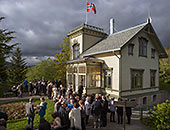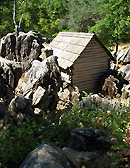 |
 |
|
 |
 |
 Clayton Lettuce –
Delicious! Nomenclature: The plant was originally called Claytonia perfoliata, and is still known in England and Europe under this botanical designation. Elsewhere it is known as Montia perfoliata, named for Giuseppe Monti, a professor of botany at the University of Cologne in the eighteenth century. The genus Claytonia is named for John Clayton (1694-1773), Clerk to the County Court of Gloucester County, Virginia, USA from 1720 until his death, one of the earliest collectors of plant specimens in that state, and described as the greatest American botanist of his day. John Clayton conscientiously and systematically took samples of everything he encountered, and sent them to Mark Catesby at Oxford, who in turn sent them to Gronovius in Leiden, Holland. The vegetable received considerable attention during the days of the California gold rush, when it served as a cheap and readily available source of greens for the miners. Unfortunately, this name carried with it the implication of a rough-and-ready emergency food, not an elegant green for proper Victorian tables. This may have helped prejudice many Americans against it in the nineteenth century, especially since it was a common “weed.” Happily, it has recently undergone a revival of interest as part of a general shift toward exploring alternative ingredients The Miners were not the only ones who appreciated miner’s lettuce. The American Indians not only ate it raw and cooked; they also made a tea from the plant, hence its other name: Indian lettuce. In England it is occasionally known as Springbeauty, while the Irish name is Plúirín earraigh. The common names of 'Winter Purslane' and 'Miners Lettuce' are misleading: it is neither a lettuce nor a purslane, although both are members of the portulaca family, which are known for their juicy, succulent leaves.
|
Hi Audrey, Love your lamb shanks. --- Paul, Scottsdale AZ
Haven't been called Tad for . . .gee, maybe I've NEVER been called Tad . . . guess I'm the only one with chutzpah enough to mention Bourdain. BRILLIANT? --- Ken, Shutesbury, MA
I think we must have had an entirely different experience in the UK. (Fresh Food and Real Ale – week 1). We were up in Edinburgh and they served something called ‘Neeps & Tatties.’ The items were boiled so long that I couldn’t even recognize what I was eating. Come to think of it… I couldn’t taste them either. Later I found that Neeps’ are Turnips and ‘Tatties’ are potatoes. --- Lindy, Phoenix, AZ
My mouth was watering as I read some of your descriptions of the fantastic fare of ... England? I had always felt smug about the lowly reputation of British cuisine as this gave us at least one country with a worse culinary reputation than America's. I guess I'll have to change my views. Your article made me actually want to take a CULINARY tour of Britain. Yummy yummy yummy. --- Sandy Miner, Portland, OR Thanks for your note. Thanks to Traveling Boy I get to interview a world famous chef this week who is widely recognized as spearheading the Yummy movement in Ireland. Guess I'll have to take yet another culinary tour a little further north and check it out... (I love my job!) --- Audrey
Very interesting, mouth-watering piece by Audrey! (A McDreamy McMeel). Your web site is fascinating! --- Susie, Victoria, BC
Combining travel, food, and intelligent advice -- BRILLIANT! Your site fills a long-felt need for hungry roamers. Keep it up! It's Anthony Bourdain with reservations and CLASS. --- Tad, Boston, MA
|
|
| ||||
|
| ||||
This site is designed and maintained by WYNK Marketing. Send all technical issues to: support@wynkmarketing.com

|





















